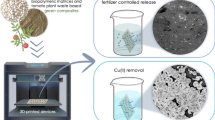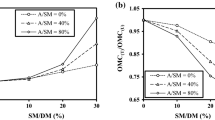Abstract
The use of fertilizer and water availability are essential factors limiting the agricultural production. The controlled release technology is very promising because it allows the maintenance of fertilizer concentrations within an ideal range avoiding inefficiency and toxicity problems, minimizing the environmental impacts and improving their efficiency. In this context, the nanostructured hydrogels appear as a possible carrier vehicle for these controlled release systems due to their inherent properties, such as biodegradability, low toxicity, and cost, rapid absorption and desorption controlled capacity of water and solutes. In this work, we performed the synthesis of nanostructured hydrogels based on poly(methacrylic acid) (PMAA)/Cloisite-Na+ via free radical polymerization. SEM images indicated a similarity in the basic structure of all nanocomposites. The porous diameter of the hydrogels increased with increasing of nanoclay content. EDS analysis showed the ions belonging to nanoclay present in the nanocomposites, confirming the formation of true nanocomposites. TG–DTG and DSC techniques confirmed an improvement in the thermal stability of nanocomposites caused by the addition of nanoclay. For instance, the degradation initial temperature of the hydrogel was increased from 198.5 to 203.5 °C, and inversely, the degradation rate of the 2° thermal event was decreased from 0.694 to 0.472% min °C−1, when the nanoclay was increased from 0 to 20 mass/%. Moreover, the controlled release investigation showed an improvement in the release time and quantity of the fertilizer released with nanoclay content. This result is very required for this specific application.







Similar content being viewed by others
References
Deng H, Song J, Elom AK, Xu J, Fan Z, Zheng C, Xing Y, Deng K. Synthesis and controlled release behavior of biodegradable polymers with pendant ibuprofen group. Int J Polym Sci. 2016;2016:5861419. doi:10.1155/2016/5861419.
Silva PCD, Portela AS, Lima RSC, Santana CP, Medeiros ACD, da Silva MO. Compatibility study between lipoic acid with polymers used in controlled drug release systems. J Therm Anal Calorim. 2016;123:965–71.
Wu L, Liu M. Preparation and properties of chitosan-coated NPK compound fertilizer with controlled-release and water-retention. Carbohydr Polym. 2008;72:240–7.
Pourvajadi A, Doulabi M, Soleyman R, Sharif S, Egthesadi SA. Synthesis and characterization of a novel (salep phosphate)-based hydrogel as a carrier matrix for fertilizer release. React Funct Polym. 2012;72:667–72.
Bortolin A, Aouada FA, Mattoso LHC, Ribeiro C. Nanocomposite PAAm/methyl cellulose/montmorillonite hydrogel: evidence of synergistic effects for the slow release of fertilizers. J Agr Food Chem. 2013;61:7431–9.
Pourjavadi A, Farhadpour B, Seidi F. Synthesis and investigation of swelling behavior of new agar based superabsorbent hydrogel as a candidate for agrochemical delivery. J Polym Res. 2009;16:655–65.
Rashidzadeh A, Olad A. Slow-released NPK fertilizer encapsulated by NaAlg-g-poly(AA-co-AAm)/MMT superabsorbent nanocomposite. Carbohydr Polym. 2014;114:269–78.
Raafat AI, Eid M, El-Arnaouty MB. Radiation synthesis of superabsorbent CMC based hydrogels for agriculture applications. Nucl Instrum Meth B. 2013;283:71–6.
Bhuyan M, Dafader NC, Hara K, Okabe H, Hidaka Y, Rahman M, Khan MMR, Rahman N. Synthesis of potato starch-acrylic-acid hydrogels by gamma radiation and their application in dye adsorption. Int J Polym Sci. 2016;2016:9867859. doi:10.1155/2016/9867859.
Guilherme MR, Aouada FA, Fajardo AR, Martins AF, Paulino AT, Davi MFT, Rubira AF, Muniz EC. Superabsorbent hydrogels based on polysaccharides for application in agriculture as soil conditioner and nutrient carrier: a review. Eur Polym J. 2015;72:365–85.
Jovanovic J, Stankovic B, Adnadjevic B. Kinetics of isothermal dehydration of equilibrium swollen PAAG hydrogel under the microwave heating conditions. J Therm Anal Calorim. 2017;127:655–62.
Anyszka R, Bielinski DM, Pedzich Z, Szumera M. Influence of surface-modified montmorillonites on properties of silicone rubber-based ceramizable composites. J Therm Anal Calorim. 2015;119:111–21.
Natkanski P, Kustrowski P, Białas A, Surman J. Effect of Fe3+ ions present in the structure of poly(acrylic acid)/montmorillonite composites on their thermal decomposition. J Therm Anal Calorim. 2013;113:335–42.
Li J, Li Y, Dong H. Controlled release of herbicide acetochlor from clay/carboxylmethylcellulose gel formulations. J Agric Food Chem. 2008;56:1336–42.
Wilpiszewska K, Spychaj T, Pazdzioch W. Carboxymethyl starch/montmorillonite composite microparticles: properties and controlled release of isoproturon. Carbohydr Polym. 2016;136:101–6.
Wang Q, Wang G, Cheng Z. Oscillatory swelling behavior of hydrogels incorporated with ion exchange nanoparticle. Drug Deliv Lett. 2011;1:58–61.
Junior CRF, de Moura MR, Aouada FA. Synthesis and characterization of intercalated nanocomposites based on poly(methacrylic acid) hydrogel and nanoclay cloisite-Na+ for possible application in agriculture. J Nanosci Nanotechnol. 2017;17:5878–83.
Mallakpour S, Dinari M. Preparation and characterization of new organoclays using natural amino acids and Cloisite Na+. Appl Clay Sci. 2011;51:353–9.
Panic VV, Madzarevic ZP, Volkov-Husovic T, Velickovic SJ. Poly(methacrylic acid) based hydrogels as sorbents for removal of cationic dye basic yellow 28: kinetics, equilibrium study and image analysis. Chem Eng J. 2013;217:192–204.
Mallakpoura S, Moslemi S. Dispersion of chiral amino acid organomodified Cloisite Na+ in poly(vinyl alcohol) matrix for designing of novel bionanocomposite films. Prog Org Coat. 2012;74:8–13.
Lapides I, Borisover M, Yariv S. Thermal analysis of hexadecyl trimethylammonium–montmorillonites. J Therm Anal Calorim. 2011;105:921–9.
Solhi L, Atai M, Nodehi A, Imani M. A novel dentin bonding system containing poly(methacrylic acid) grafted nanoclay: synthesis, characterization and properties. Dent Mater. 2012;28:1041–50.
Zhang Y, Jin Q, Zhao J, Wu C, Fan Q, Wu Q. Facile fabrication of pH-sensitive core–shell nanoparticles based on HEC and PMAA via template polymerization. Eur Polym J. 2010;46:1425–35.
Yang M. On the thermal degradation of poly(styrene sulfone)s. V. Thermogravimetric kinetic simulation of polyacrylamide pyrolysis. J Appl Polym Sci. 2002;85:1540–8.
Gupta B, Gautam D, Anjum S, Saxena S, Kapil A. Radiation synthesis of nanosilver nanohydrogels of poly(methacrylic acid). Radiat Phys Chem. 2013;92:54–60.
Mallakpour S, Dinari M. Biomodification of cloisite-Na+ with l-methionine amino acid and preparation of poly(vinyl alcohol)/organoclay nanocomposite films. J Appl Polym Sci. 2012;124:4322–30.
Dumitrescu AM, Lisa G, Iordan AR, Tudorache F, Petrila I, Borhan AI, Palamaru MN, Mihailescu C, Leontie L, Munteanu C. Ni ferrite highly organized as humidity sensors. Mater Chem Phys. 2015;156:170–9.
Valderruten NE, Valverde JD, Zuluaga F, Ruiz-Durántez E. Synthesis and characterization of chitosan hydrogels cross-linked with dicarboxylic acids. React Funct Polym. 2014;84:21–8.
Pisis P, Kyritsis A. Hydration studies in polymer hydrogels. J Polym Sci Pt B Polym Phys. 2013;51:159–75.
Acknowledgements
The authors are grateful to Universidade Estadual Paulista, and Brazilian research financing institutions Fundação de Amparo à Pesquisa do Estado de São Paulo (FAPESP), Conselho Nacional de Desenvolvimento Científico e Tecnológico (CNPq) and Coordenação de Aperfeiçoamento de Pessoal de Nível Superior (CAPES) for their financial support.
Author information
Authors and Affiliations
Corresponding author
Rights and permissions
About this article
Cite this article
Junior, C.R.F., Tanaka, F.N., Bortolin, A. et al. Thermal and morphological characterization of highly porous nanocomposites for possible application in potassium controlled release. J Therm Anal Calorim 131, 2205–2212 (2018). https://doi.org/10.1007/s10973-017-6755-9
Received:
Accepted:
Published:
Issue Date:
DOI: https://doi.org/10.1007/s10973-017-6755-9




